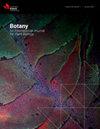异养真菌植物作为农业后森林更新的指示物:农业后森林中单、单植物丰度随时间的变化而变化
IF 1.3
4区 生物学
Q3 PLANT SCIENCES
引用次数: 0
摘要
次生林的草本层受过去土地利用的影响。农业等干扰可能通过改变菌根群落或移除它们赖以获取碳的树木,影响从真菌网络中获取碳的非光合菌根植物——异养菌的种群。我测试了两种真菌异养森林草本植物在演替过程中丰度增加的假设,并且随着时间的推移,随着植物群落的重新组合,在老森林中变得最常见。对美国俄亥俄州阿森斯县单色单盲蝽和单色单盲蝽的分布进行了调查。我在一个40个样点的农业后森林时间序列中调查了5个高地样点和5个山谷样点,每个样点在冠层关闭后的40-60年、61-80年、81-100年和>130年四个年龄类别中。测量坡向和海拔以评估环境影响。 在EM树丰富的林冠组成和向西或向南的老林分中,单绿毛茛和单绿毛茛最常见,这表明历史、生物和土壤因素的影响。低度生长是森林的专利。80岁,而uniflora存在于年轻林分。两种植物的丰度也可以用壳斗科的基面积来预测。由于EM树在南向和西向高地也最为丰富,因此环境影响似乎是通过冠层组成介导的。 & # x0D;本文章由计算机程序翻译,如有差异,请以英文原文为准。
Mycoheterotrophic plants as indicators of post-agricultural forest regeneration: abundance of Hypopitys monotropa and Monotropa uniflora in post-agricultural forests changes through time
Herbaceous layers in second-growth forests are shaped by past land use. Disturbances such as agriculture may impact populations of mycoheterotrophs, non-photosynthetic mycorrhizal plants that obtain carbon from fungal networks, by altering mycorrhizal communities or removing trees they derive carbon from. I tested the hypotheses that two mycoheterotrophic forest herbs increase in abundance during succession and become most common in older forests as plant communities reassemble through time.
Distributions of Hypopitys monotropa and Monotropa uniflora, were sampled in Athens County, Ohio, USA. I surveyed populations in a 40-site post-agricultural forest chronosequence with five upland and five valley sites in each of four age classes: 40-60, 61-80, 81-100, and >130 years since canopy closure. Aspect and elevation were measured to assess environmental influence.
Both H. monotropa and M. uniflora were most common in older stands with EM tree-rich canopy composition and West or South-facing aspects, indicating influence of historical, biotic, and edaphic factors. Hypopitys was exclusive to forests > 80 years old, while M. uniflora was present in younger stands. Abundance of both species was also significantly predicted by Fagaceae basal area. Because EM trees were also most abundant in South-and West-facing uplands, environmental influence appears to be mediated through canopy composition.
求助全文
通过发布文献求助,成功后即可免费获取论文全文。
去求助
来源期刊

Botany
生物-植物科学
CiteScore
2.20
自引率
9.10%
发文量
48
期刊介绍:
Botany features comprehensive research articles and notes in all segments of plant sciences, including cell and molecular biology, ecology, mycology and plant-microbe interactions, phycology, physiology and biochemistry, structure and development, genetics, systematics, and phytogeography. It also publishes methods, commentary, and review articles on topics of current interest, contributed by internationally recognized scientists.
 求助内容:
求助内容: 应助结果提醒方式:
应助结果提醒方式:


